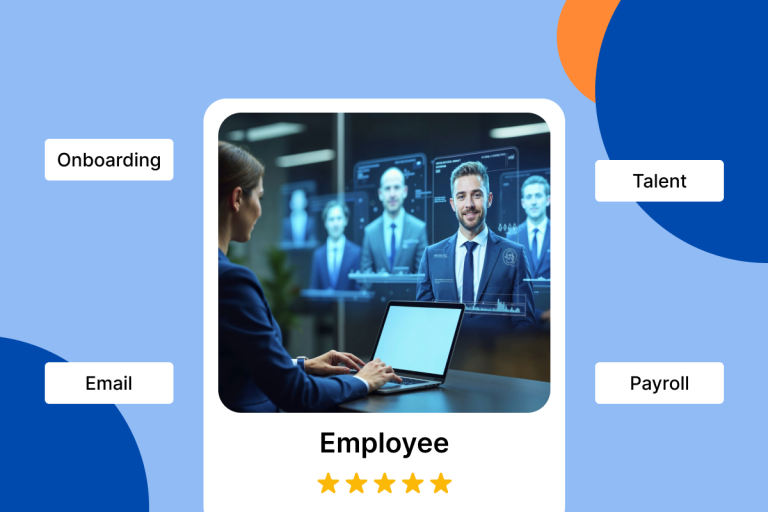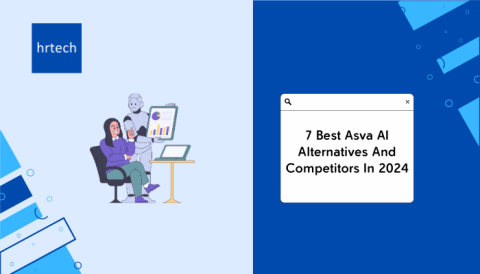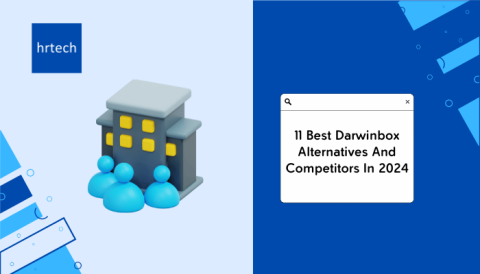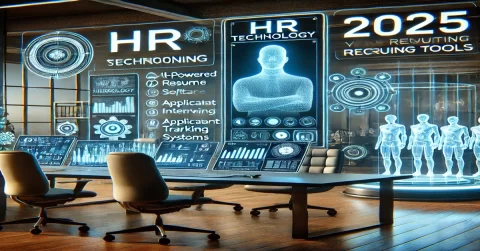Introduction
Onboarding can sometimes be a bit of a drag. But what if I told you there’s a way to simplify this process and make it a breeze for both new hires and your HR team? Enter: onboarding automation.
A positive onboarding experience sets the tone for the entire employee journey. When new hires feel welcomed and supported, they’re more likely to be engaged, productive, and stay with your company long-term.
Think of it as upgrading from a manual typewriter to a word processor. You’re still accomplishing the same goal (creating a document), but the process is significantly faster, more efficient, and less prone to errors. Automation does the same for onboarding. It handles all those tedious administrative tasks, freeing up your HR team to focus on what truly matters: building a strong and welcoming company culture. So, what exactly does “onboarding automation” entail?
What Is HR Onboarding Automation?
HR onboarding automation involves leveraging technology to streamline and simplify the administrative tasks associated with welcoming new employees. This can include automating tasks like data entry, document processing, and communication, ultimately freeing up HR professionals to focus on more strategic initiatives.
Why automate onboarding?
Transitioning from manual to automated onboarding brings numerous benefits:
- Enhanced efficiency: Automating repetitive tasks like data entry and document processing significantly improves HR efficiency.
- Improved employee experience: Automated systems can provide a more personalized and engaging onboarding experience for new hires.
- Reduced errors: Automation minimizes the risk of human error in data entry and document processing.
- Time savings: Automating tasks frees up HR professionals to focus on more strategic initiatives, such as employee engagement and development.
- Increased employee satisfaction: A smoother, more efficient onboarding process can significantly improve employee satisfaction and retention.
HRtech offers a multitude of solutions to automate such tasks effectively, enabling HR teams to work smarter.
Methods To Automate HR Onboarding
Several key methods can be employed to automate your HR onboarding process. Let’s dive deeper into some of the methods you can use to automate the process:
Workflow automation
Imagine a digital assembly line for onboarding. The best workflow automation software automates the flow of tasks, such as:
- Data entry: Say goodbye to manual data entry! This software automatically populates employee information into your HRIS (Human Resources Information System), eliminating the risk of errors and saving valuable time.
- Background checks: Seamlessly integrate with background check providers to initiate and track background checks, ensuring a smooth and efficient process.
- Equipment provisioning: Automate the ordering and provisioning of company laptops, phones, and other necessary equipment. The system can even track the delivery and ensure everything arrives on time.
- Compliance checks: Automate compliance checks, such as I-9 verification and tax withholding, to ensure you’re meeting all legal requirements.
AI-powered chatbots
Think of AI chatbots as your friendly virtual assistants. These intelligent bots are available 24/7 to answer new hires’ questions, provide instant support, and guide them through the onboarding process.
- Instant answers: New hires can quickly find answers to common questions about benefits, company policies, and office locations, without having to wait for a response from HR.
- Personalized guidance: Chatbots can provide personalized guidance based on the new hire’s role and department, ensuring they have the information they need, when they need it.
- Improved engagement: Chatbots can make the onboarding process more engaging and interactive, fostering a positive first impression.
Virtual onboarding platforms
Say goodbye to stacks of paper and hello to interactive digital experiences. Virtual onboarding platforms offer a centralized hub for all onboarding activities:
- Online training modules: Deliver engaging and interactive training modules on company policies, safety procedures, and other important topics.
- Virtual meet-and-greets: Facilitate virtual meet-and-greets with team members and managers, allowing new hires to connect with their colleagues and build relationships.
- Interactive quizzes and assessments: Test new hire knowledge and understanding through interactive quizzes and assessments, providing immediate feedback and identifying areas for improvement.
- Centralized communication: Serve as a central communication hub for all onboarding-related information, ensuring everyone is on the same page.
Automated document and signature management
Streamline the collection and processing of essential onboarding documents with digital tools:
- Electronic signatures: Eliminate the need for paper documents and ink signatures by using electronic signature tools. This speeds up the process and improves efficiency.
- Secure document storage: Store all onboarding documents securely in a centralized electronic repository, ensuring easy access and compliance with data privacy regulations.
- Automated workflows: Automate document workflows, such as sending welcome packets, collecting required forms, and tracking document completion.
By implementing these methods, you can significantly streamline your HR onboarding process, improve the employee experience, and free up your HR team to focus on more strategic initiatives.
HRtech hosts a range of virtual platforms that centralize and improve onboarding communications and activities.
Alright, let’s get into what specific tasks can actually be streamlined with this handy automation.
Tasks That Can Be Streamlined Using HR Automation
Onboarding automation can streamline numerous aspects of the employee journey, including:
Automated Setup:
- Effortless account creation: New hire profiles are automatically created in the HRIS, and company email accounts are instantly provisioned.
- Seamless system access: Access to critical company systems like internal databases and project management tools is granted automatically, ensuring a smooth start.
Application and Equipment Provisioning:
- Streamlined IT logistics: The ordering and delivery of essential equipment like laptops and phones are automated, ensuring everything is ready and waiting for the new hire’s arrival.
- Software simplified: Necessary software and licenses are automatically installed on company devices, minimizing IT support requests and maximizing productivity from day one.
Scheduling Made Easy:
- Automated meeting scheduling: Orientation meetings, introductory calls with team members, and mandatory training sessions are automatically scheduled, eliminating the need for manual coordination.
Document Distribution Simplified:
- Digital welcome packets: Essential onboarding documents, including the employee handbook, benefits information, and company policies, are automatically distributed through a secure digital portal.
- Easy access: New hires have convenient access to all necessary documents in one centralized location, eliminating the need for paper shuffling.
Mentorship Matching:
- AI-powered connections: AI algorithms intelligently match new hires with suitable mentors based on their skills, interests, and career goals, fostering valuable relationships.
- Skill-based matching: The system prioritizes mentors with expertise in the new hire’s specific role and department, ensuring relevant guidance and support.
Now that we’ve touched on tasks, let’s dive into the overall advantages of automation.
Benefits Of Automated Onboarding
Onboarding automation offers a wealth of benefits for both employees and organizations. By streamlining administrative tasks and enhancing the overall employee experience, automation can significantly improve efficiency, reduce errors, and boost employee satisfaction. Let’s explore some of the key advantages in more detail:
| Benefit | Description |
| Increased HR Efficiency | Frees up HR teams to focus on strategic initiatives like employee engagement and development.Enables HR teams to onboard a larger number of employees with the same resources. |
| Enhanced Employee Experience | Provides a more personalized and welcoming onboarding experience.Offers engaging and interactive learning experiences. Improves communication and support through 24/7 access to information. |
| Significant Time Savings | Reduces the time spent on repetitive tasks like data entry and document processing.Streamlines the entire onboarding process, allowing for faster time-to-productivity. |
| Reduced Errors and Increased Accuracy | Minimizes the risk of human error in data entry and document processing.Ensures compliance with all relevant regulations and reduces the likelihood of costly mistakes. |
| Improved Employee Satisfaction and Retention | Creates a positive and welcoming first impression for new hires.Increases employee engagement and satisfaction.Reduces employee turnover and improves workforce stability. |
HRtech‘s solutions provide the enhancements necessary to personalize and streamline your onboarding efforts seamlessly.
Moving on, let’s break down the automation process in a step-by-step manner so you can get started on the right foot.
Implementing Automated Onboarding: A Step-by-Step Guide
Successfully implementing an automated onboarding system requires careful planning and a phased approach. Here’s a breakdown of key steps:
1. Analyze Your Current Onboarding Process:
Identify bottlenecks:
Pinpoint the specific areas within your current onboarding process that are most time-consuming, inefficient, or prone to errors.
- Examples: Manual data entry, delays in equipment provisioning, inconsistent communication, and a lack of centralized information.
Gather stakeholder input:
Involve key stakeholders, including HR representatives, IT personnel, managers, and even new hires themselves, to gain valuable insights into the current process and identify areas for improvement.
2. Establish a Service Catalog for Streamlined Onboarding:
- Implement a service catalog within your IT service management (ITSM) system or a similar platform.
- Create a dedicated service item for employee onboarding requests.
- Design a comprehensive request form that captures all necessary information from HR Business Partners or the new hire’s manager, such as employee details, job role, start date, required equipment, and training needs.
- This structured approach ensures all necessary information is collected upfront, minimizing back-and-forth communication and streamlining the onboarding process.
- Consider integrating an AI assistant within the service catalog to enable conversational request submission via platforms like Slack or Microsoft Teams. This allows HR managers or line managers to easily raise onboarding requests through their preferred communication channels.
3. Define Clear Objectives and Goals:
Set measurable targets:
Establish specific, measurable, achievable, relevant, and time-bound (SMART) goals for your automated onboarding system.
- Examples: Reduce time-to-productivity by 15%, improve employee satisfaction scores by 10%, or decrease onboarding-related administrative costs by 20%.
Prioritize automation:
Focus on automating the tasks that will have the greatest impact on achieving your objectives and improving the overall employee experience.
4. Choose the Right Technology:
Select appropriate software:
Research and select onboarding software that aligns with your specific needs and budget. Consider features such as:
- Workflow automation capabilities
- Integration with your HRIS and other systems
- AI-powered features like chatbots and personalized recommendations
- User-friendly interface for both HR and new hires
Evaluate vendor options:
Compare different vendors, request demos, and carefully evaluate their offerings based on your specific requirements and budget constraints.
5. Design and Develop Your Automated Workflow:
- Map the onboarding journey: Create a detailed workflow diagram that outlines all the steps involved in the onboarding process.
- Integrate with existing systems: Work closely with your IT team to ensure seamless integration between the new onboarding software and existing systems, such as your HRIS, email, and communication platforms.
- Test and refine: Thoroughly test the automated workflows to identify and address any potential issues or bottlenecks.
6. Leverage AI-Powered Assistants:
- Integrate an AI-powered assistant within the service catalog to enable conversational request submission.
- Allow HR managers or the new hire’s manager to raise onboarding requests conversationally through platforms like Slack or Microsoft Teams.
- The AI assistant can guide users through the request process, answer basic questions, and automatically populate certain fields based on user input, further streamlining the process.
7. Train Your Team:
- Comprehensive training: Provide comprehensive training to all HR personnel on the new onboarding software, its features, and how to effectively utilize it.
- Ongoing support: Offer ongoing support and resources to ensure that HR staff are comfortable using the new system and can effectively address any questions or concerns.
8. Monitor, Measure, and Refine:
- Track key metrics: Continuously monitor key metrics, such as time-to-productivity, employee satisfaction scores, and onboarding costs, to assess the effectiveness of the automated system.
- Gather feedback: Regularly gather feedback from both new hires and HR staff to identify areas for improvement and ensure that the onboarding process remains effective and engaging.
- Make adjustments: Based on the data and feedback collected, make necessary adjustments to the automated workflows, content, and processes to optimize the onboarding experience.
Consider HRtech‘s marketplace as a valuable resource for finding the most effective onboarding software tailored to your organizational needs.
Best Practices for Successful Onboarding Automation
To ensure successful implementation of onboarding automation, it’s crucial to follow best practices that maximize its effectiveness and minimize potential challenges. Here is a list of practices that you can keep handy:
- Align with company objectives: Ensure that your automation goals align with your overall company objectives and strategic priorities.
- Create engaging content: Create engaging and interactive onboarding content that keeps new hires interested and informed.
- Use consistent processes: Establish and maintain consistent processes and platforms across all stages of the onboarding journey.
- Regularly measure and analyze: Regularly measure and analyze key onboarding metrics, such as time-to-hire, employee satisfaction, and retention rates, to identify areas for improvement.
As with any new initiative, implementing onboarding automation may present some challenges. Let’s explore some common hurdles and how to overcome them.
Probable Challenges and Solutions for HR Onboarding Automation
While onboarding automation offers numerous benefits, it’s important to acknowledge and address potential challenges:
1. Risk of an Impersonal Experience:
Challenge:
Over-reliance on technology can lead to a depersonalized onboarding experience, leaving new hires feeling isolated and disconnected.
Solution:
- Human touch: Incorporate opportunities for human interaction throughout the process, such as virtual coffee chats, team lunches, and dedicated mentorship programs.
- Personalized welcome messages: Send personalized welcome messages from managers and team members to foster a sense of belonging and connection.
- Social onboarding activities: Organize virtual or in-person social events to facilitate interaction and team building among new hires.
2. Slow Administrative Processes:
Challenge:
Despite automation, some administrative processes, such as background checks and document verification, can still be time-consuming and create bottlenecks.
Solution:
- Streamline background checks: Leverage AI-powered solutions to automate and accelerate background checks, reducing processing times and minimizing delays.
- Digitalize document verification: Utilize electronic signature tools and automated document verification systems to streamline the collection and processing of essential documents.
- Optimize data entry: Implement robust data entry systems that minimize manual input and reduce the risk of errors.
3. Inconsistent Communication and Information:
Challenge:
Inconsistent communication and information flow can lead to confusion, frustration, and a poor onboarding experience for new hires.
Solution:
- Centralized communication hub: Implement a central communication hub, such as an internal messaging platform or an employee portal, to ensure all onboarding-related information is easily accessible in one location.
- Automated communication triggers: Utilize automated communication triggers to send timely reminders, notifications, and updates throughout the onboarding process.
- Regular check-ins: Conduct regular check-ins with new hires to address any questions or concerns and ensure they are successfully navigating the onboarding process.
By proactively addressing these challenges and implementing appropriate solutions, organizations can maximize the benefits of onboarding automation while ensuring a positive and engaging experience for all new hires.
Conclusion
HR onboarding automation is no longer a luxury; it’s a necessity for modern businesses. By leveraging technology to streamline and simplify the onboarding process, organizations can improve efficiency, enhance the employee experience, and ultimately drive better business outcomes. As technology continues to evolve, we can expect to see even more innovative solutions for automating HR onboarding in the years to come.
Ready to take your onboarding automation to the next level? Explore the vast selection of HR technology solutions available on HRtech, the leading HR Technology marketplace in Asia & the Middle East.
Visit HRtech today and discover how HR technology can transform your onboarding experience!





